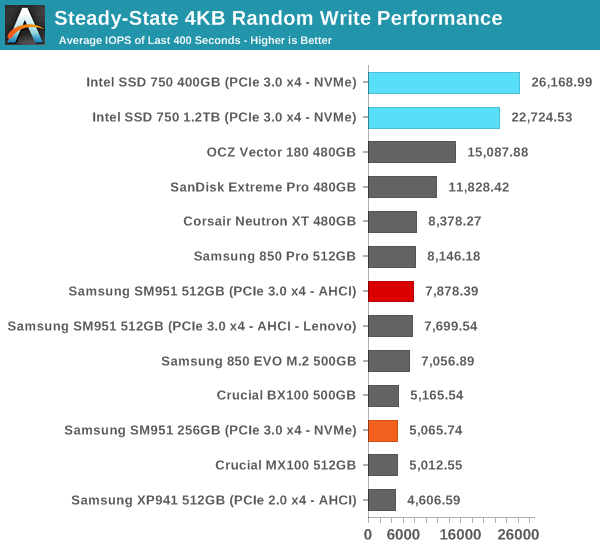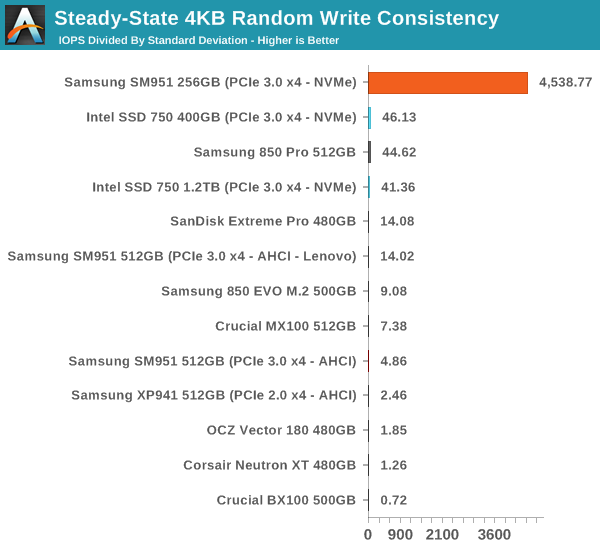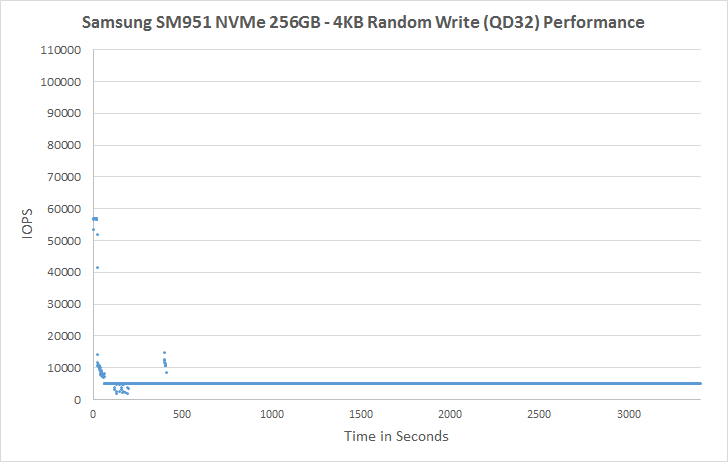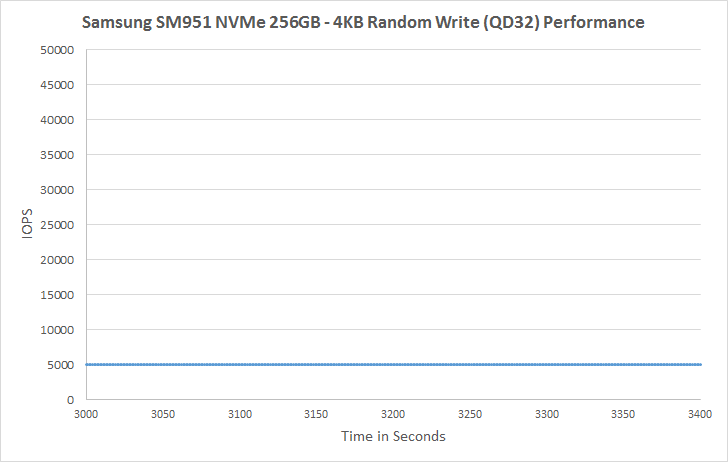Samsung SM951-NVMe (256GB) PCIe SSD Review
by Kristian Vättö on June 25, 2015 9:40 AM ESTPerformance Consistency
We've been looking at performance consistency since the Intel SSD DC S3700 review in late 2012 and it has become one of the cornerstones of our SSD reviews. Back in the days many SSD vendors were only focusing on high peak performance, which unfortunately came at the cost of sustained performance. In other words, the drives would push high IOPS in certain synthetic scenarios to provide nice marketing numbers, but as soon as you pushed the drive for more than a few minutes you could easily run into hiccups caused by poor performance consistency.
Once we started exploring IO consistency, nearly all SSD manufacturers made a move to improve consistency and for the 2015 suite, I haven't made any significant changes to the methodology we use to test IO consistency. The biggest change is the move from VDBench to Iometer 1.1.0 as the benchmarking software and I've also extended the test from 2000 seconds to a full hour to ensure that all drives hit steady-state during the test.
For better readability, I now provide bar graphs with the first one being an average IOPS of the last 400 seconds and the second graph displaying the standard deviation during the same period. Average IOPS provides a quick look into overall performance, but it can easily hide bad consistency, so looking at standard deviation is necessary for a complete look into consistency.
I'm still providing the same scatter graphs too, of course. However, I decided to dump the logarithmic graphs and go linear-only since logarithmic graphs aren't as accurate and can be hard to interpret for those who aren't familiar with them. I provide two graphs: one that includes the whole duration of the test and another that focuses on the last 400 seconds of the test to get a better scope into steady-state performance.

Steady-state performance isn't mind blowing, although it's a little unfair to compare the 256GB SM951-NVMe against a 512GB SM951-AHCI because available NAND throughput can play a major role in steady-state performance with a properly designed controller and firmware.

The mediocre steady-state performance is replaced by outstanding consistency, though. During the last 400 seconds, the SM951-NVMe has standard deviation of only 1.12, whereas the next drives are in the order of hundreds with many drives surpassing 1,000.
 |
|||||||||
| Default | |||||||||
As there's practically no variation in performance, the graph is just a straight line after the initial cliff. There are zero up and down swings, which is something I've yet to see even in an enterprise SSD. Samsung has always done well in IO consistency, but in all honesty the SM951-NVMe sets a new bar for consistency. On the downside, I would rather take some variation with higher performance because especially for client workloads such level of consistency isn't really needed, but increased performance can always help with intensive IO workloads. Nevertheless, I'm very happy with the direction Samsung is taking because we still see some controller vendors not paying enough attention to consistency, but it's clearly a high priority for Samsung.
Unfortunately I couldn't run any tests with added over-provisioning because the hdparm commands I use for limiting the capacity do not work with NVMe drives. There are similar commands for NVMe drives too, but for now there is no publicly available utility for issuing those commands.
 |
|||||||||
| Default | |||||||||










74 Comments
View All Comments
Laststop311 - Friday, June 26, 2015 - link
the pci-e ssd's also improve the 4k qd1/2 as well not by huge amounts but it is faster in that as well.cenpjas - Monday, June 29, 2015 - link
Ignoring OS for the moment, I am not so sure about "for the end consumer I'm not sure it matters as much over a SATA SSD. After all, the typical average user probably values the 4k @QD1/2 above all else, so perhaps these PCI-E SSDs will remain a niche product, unless the price reaches near parity with SATA SSDs, which won't happen for at least a few years."Currently most people build there own computers are for gaming or specialist use and it is a large market. The advantages of M.2 drives is not just the 4 fold increase in read or 3 fold increase in write speeds over SATA SSD (based on a SM951 VS 850 Evo) but an improved latency over these 'legacy' SSD's. So if your going to throw down £600 for a graphics card would you think twice about a 'mear' £100 more for a 512Gb SM951 VS 500Gb 850 Evo?
For me M.2 is here and now, and SATA SSD's are secondary storage drives. As I build my self very small computers, I like the storage taking up no space in the case. (although I suspect a few small heat sinks in the short term on the drives will need to be the case in a restricted air flow environment). As far as I can tell the SM951-NVMe just makes me more certain that I want it as my primary drive.
As for Win10.0.0 I notice from the Open Beta's that out the box boot support is very good and I can not imagine there being no out the box support for all M.2 type devices, after all, these are OEM for the most part.
epobirs - Thursday, July 2, 2015 - link
You've got to be kidding. An order of magnitude performance increase will become a serious market driver once mainstream availability is there. It's one of those things that has to be experienced to be appreciated. There was a time when SSDs in general seemed like an exotic upgrade for the hot rodders who spent absurd amounts on their systems. Now, I wouldn't consider building a new system without one unless price was the sole priority.There is no reason for the price gap to last beyond this year. Once the chip sets are in production with shippable firmware you're looking at mostly the same same silicon for nearly the entire product. Since prices are very much lower than when SSDs hit the market, PC OEMs aren't faced with the same marketing problems as before. (Though what would remove the final barrier would be for Microsoft to offer functionality comparable to the Apple Fusion Drive in Windows 10.) The cost of having a conventional SATA hard drive for bulk storage alongside a 256-ish GB PCIe SSD for OS and apps is far lower than when the same companies were faced with decisions on how to offer SATA SSDs.
IMHO, the mainstream market will never experience SATA SSD but instead will go direct to PCIe SSDs because that will be the first version the PC OEMs push for mainstream consumers.
dgingeri - Thursday, June 25, 2015 - link
I'd still prefer my 512GB 850 Pro over this.vnangia - Thursday, June 25, 2015 - link
Curious why? Is it just cost-related?I actually recently bought an XP941 to use as a boot drive and have been damn impressed; I needed all the SATA ports for a ZFS array. Even in AHCI mode, it clocked in 850 read/700 write typical, with a peak of 1100/850.
Notmyusualid - Sunday, June 28, 2015 - link
Sounds butt hurt to me...Impulses - Thursday, June 25, 2015 - link
I think I'd like a 256GB SM951 + 1TB 850 EVO setup... Probably going for the latter first tho, my 2x 128GB 830 are definitely getting a little long in the tooth and ditching the games/media drive would be sweet.scan80269 - Thursday, June 25, 2015 - link
Hi Kristian, the Z97 motherboard you used to test SM951 supports only up to PCIe gen2. The SM951 (both AHCI & NVMe versions) support up to PCIe x4 gen3. The sequential read & write figures are lower with the SM951 running at PCIe gen2 compared to gen3. To run SM951 at PCIe gen3 speed you will need an upcoming Intel Skylake platform, with something like Z170 chipset. Even Intel's Broadwell CPUs (like in that NUC) support up to PCIe gen2 only.wyysoft - Thursday, June 25, 2015 - link
Why can’t Z97 support PCIe Gen3? No Z170 chipset is needed to get PCIe Gen3 results.Kristian Vättö - Thursday, June 25, 2015 - link
The SSD is connected directly to the CPU's PCIe lanes and Intel's CPUs have supported PCIe Gen 3 since Ivy Bridge. Skylake and 100-series chipsets will only affect the PCIe lanes coming from the PCH.